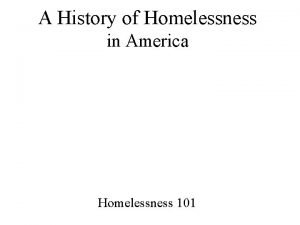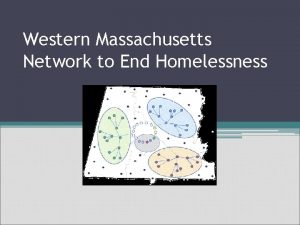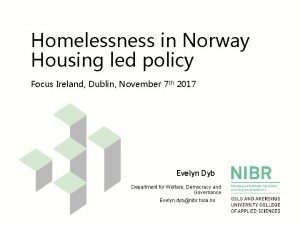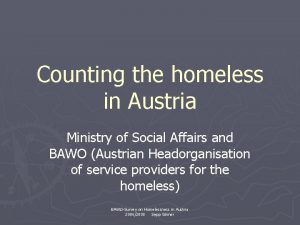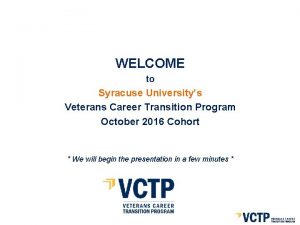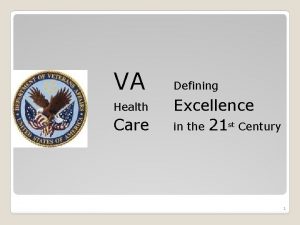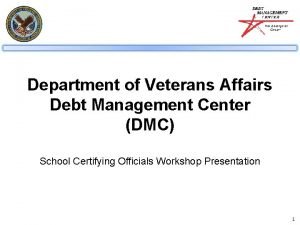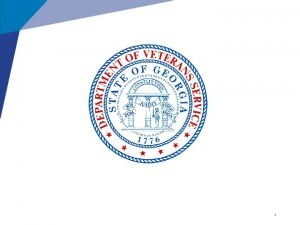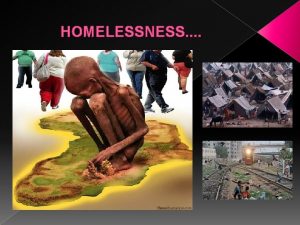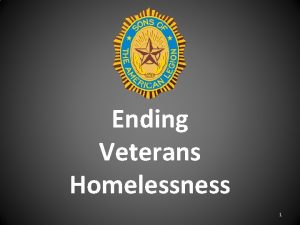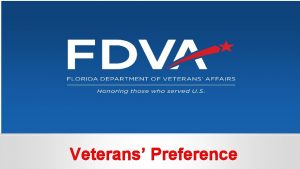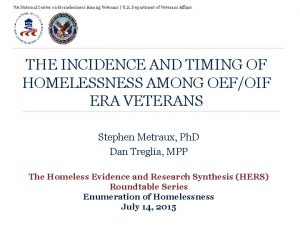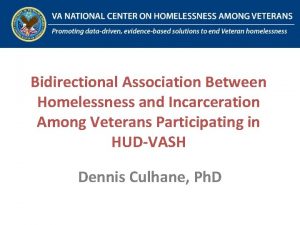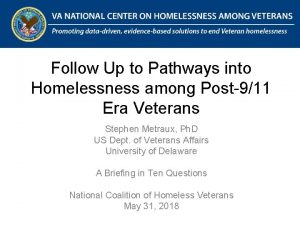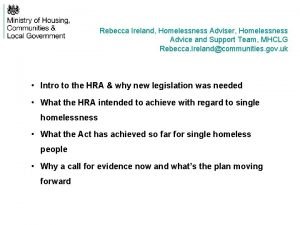Homelessness Among Rural Veterans HUDVASH Monthly Clinical Call






















- Slides: 22

Homelessness Among Rural Veterans HUD-VASH Monthly Clinical Call December 15, 2016 Hilda R. Heady, MSW Senior Vice President Atlas Research Amy Miller, BA Program Manager Atlas Research Samantha Rudnick, MPH Program Manager Atlas Research

Challenges to Providing Services in Rural Areas

Challenges to Providing Service in Rural Areas • Higher Physical Health Needs • Financial Barriers • Higher Rates of Mental Health Needs • Shortage of Services • Inflexibility of Available Resources • Fewer Health Resources • Isolation • Barriers to Employment • Transportation & Travel Distance • Barriers to Service Applications • A Shortage of High-Quality Affordable Housing • Stigma • Impedes Access • Undermines Coordination • Threatens Care Quality 3

Types and Effects of Stigma Affecting Homeless in Rural Areas Stigma Defined A complex process involving stereotypes and prejudices about marginalized groups that results in discrimination. Attitudes about specific individuals or groups result in a behavior that leads to LOST OPPORTUNITIES. Rural Stigma • A Veteran may not seek services for fear of seeing someone they know. • Veteran fears that word will spread about their situation in a small community. Fear that they and other family members may be stigmatized. Effects of Stigma • A Veteran may not seek needed services and may lead to worsen issues. Reducing Stigma • Incorporate stigma reduction strategies into staff training. • Include stigma assessment and interventions throughout clinical treatment. • Focus on changing behaviors rather than changing attitudes. • Ensure client privacy policies and practices are up to date and followed. 4

Engaging Homeless Individuals in Rural Communities

Hidden Population: Where • Rural landscapes camouflage homelessness • Large spaces with lots of hiding places o More likely to live in substandard and abandoned houses, cars, boats, sheds, barns o Campgrounds, national and state parks, deer stands, duck blinds, rock enclosures, up creeks and river banks 6

Hidden Population: Why • Limited organized emergency shelters • Fear of being stigmatized • Lack of trust of government resources • Houseless versus homeless results in miscategorization • Undercounting impacts policies and resources 7

Using Local “Helping” and Service Resources • Law Enforcement: County Sheriff, City and State Police • Schools: Principals, Guidance Counselors, School Bus Drivers • • Local and Regional Jails • Churches, Ministers and Congregations • • Low rate Motels • EMT, ER Nurses, Hospitals, Rural Clinics, Free Clinics • Rural Letter Carriers Associations Human Services, Mental Health, Substance Abuse Personnel • • National Guard Units County Veteran Service Officers Chartered Veteran Service Organizations (VSOs) Missions, Soup Kitchens, Food Pantries, and Warming Shelters https: //www. nrlca. org/ Federal and State Park Rangers 8

Rural Outreach Strategies • Focus on places where people could hide, but still have easy access to a bathroom, water and food o Gas stations o Homeless shelters (in nearby towns on bus lines) o Under bridges and places near bodies of water o RV parks, campers • Focus on places where people can spend their time for free o Libraries o Outside hospital emergency rooms, especially after midnight o Bars o Abandoned buildings o Highway intersections o Large box stores (behind or near entrances during open hours) 9

Positive/Appreciative Outreach Team “I always try to acknowledge all that they have survived, and the political freedom they have offered to us, through their service and sacrifice. It has often surprised me when Veterans, especially the Vietnam Era Veterans, tell me that I was the first person to thank them for their service to our country. ” - Barbara Lucci, PATH Outreach Clinician, Eliot Community Human Services, Worcester, Massachusetts 10

Strategies to Increase Impact of Services in Rural Communities

Potential Resources and Strategies • Potential Housing Resources o o o o Home Ownership programs (i. e. , VA or HUD sponsored) HUD-VA Supportive Housing (HUD-VASH) Grant Per Diem (GPD) Co. C Housing Programs Public Housing Authorities Emergency Solutions Grant Programs Supportive Services for Veteran Families Programs (SSVF) • Employment Resources o o o Workforce Investment Boards (WIB) Goodwill Career Centers Community Colleges and Higher Education Veteran Programs Homeless Veteran Reintegration Programs VA Community Employment Coordinators (CECs) State Employment Agencies 12

Importance of Collaboration to Identify New Resource Strategies VA Staff cannot solicit donations, so strategic collaboration is key. 1. Connect with VA Volunteer Services to identify available community resources. 2. Develop strategic partnerships with local community groups: • • Faith-based Organizations Local Government Community Groups and Clubs Local Meetings, Town Halls • • Schools and Unions Businesses Local and large chain stores Foundations 3. Work with community partners to identify the needs of Veterans in rural communities. 4. Establish a collaborative plan to meet needs. 13

Teaming Strategies • An Intensive Case Management (ICM) service design is important. • Co-locate with Other Providers and Offices o SSVF and HUD-VASH spend time weekly at each other’s site. o Accomplishes multiple goals: Allow for fast screening of new clients for both programs; Ensure that proper paperwork is included for eligibility in both programs; Integrate case management and ensure Veteran needs are met, who is doing housing search, who is taking clients to view units. o Addresses transportation issues. • Educate Area Providers on Program Requirements o Through presentations and “fact sheets” ensure each agency understands eligibility. o Accomplishes multiple goals: Cut down on ineligible referrals; Less frustration for Veteran being passed if ineligible; Less time spent on wrong resources which delay addressing housing crisis. o Builds trust with providers as well as Veterans. 14

Guidance to VHA employees regarding participation on local Co. C Boards: “VHA HPO encourages all VA Medical Centers’ homeless programs to be fully engaged with their local Co. C (Continuum of Care), to the fullest extent possible. The Co. C Program is designed to promote communitywide commitment to the goal of ending homelessness, and providing guidance and recommendations as to what is needed to serve the homeless populations in a given community. Because each of these communities includes the Veteran population, local VA support and participation is essential to the Co. C process. VHA employees are legally permitted to participate in and serve on local Co. C boards, and approval for participation in this capacity should be granted by the facility’s medical center leadership or designee. Recusal from Co. C board decision-making processes would only be required if the employee has an outside position with/interest in a local organization seeking HUD funding. Otherwise the employee is permitted to participate fully in their role as a Co. C board member. In fact, HUD regulations provide for participation by other Federal agencies on local Co. Cs, including input into establishing priorities for funding projects in the geographic area. ” Developed by General Counsel in partnership with HPO – Guidance Issued 10/18/16 15

No Local Resources? Count on Two Levels of Engagement Client: Community: • Engage those Veterans who self-identify • Be fully engaged with local Co. C • Understand the challenges that are unique to EACH Veteran • Produce community awareness o Transportation hurdles and plans o Standing weekly meeting o Active housing plan going with the Veteran with action steps and frequent contact required o Develop plan with other providers o Plan client meetings immediately before/after medical appointments. o Ensure communication (Safe. Link phone) • Reach Veterans through established community channels o Questions added to school questionnaires for parents o Educate VA and non-VA medical providers o Flyers strategically placed around town • Be involved in the community o Participate in community events o Understand uniqueness of each rural community 16

Strategies used by Rural SSVF Providers • General approaches of Rural SSVF grantees who serve large geographic areas/Balance of State Co. C. o Designated team members per geographic region, who are from those regions o Focus on building strong community partnerships to advocate for the organization in remote locations. Many rely on referrals from these partnerships. o Hard copy materials designed to be left: Many noted leaving flyers, brochures etc. at gas stations, department stores, or anywhere that a Veteran might show up. • Engage large box/discount stores in outreach (some homeless panhandle near these stores or sleep behind them. • County Veteran Service Officers are very important in widespread areas • Partnerships and collaboration are critical to covering these areas • Allow organic growth of resources and partnerships 17

Critical Success Factors Strategies used by Rural Co. Cs 1. An identified “Glue Person” that maintains both a high level of understanding and detailed perspective of the VA, Co. C and their activities 2. A “Champion” for ending homelessness that has the trust and respect of community members, as well as the skills to build relationships both inside and outside of the homeless system 3. A high level of stakeholder involvement and leadership in the Co. C planning process 4. Implementation strategies that reinforce inclusion, coordination, and collaboration across homeless system agencies and programs, both public and private 5. A willingness to think “outside of the box” to achieve key goals within the homelessness assistance system 18

Strong HUD-VASH Rural Practices: Examples from Alaska VAMC and Western New York HCS

Strong HUD-VASH Rural Practices • Maximize community partners o Co-location o Reassigning pieces of positions • Advocate for landlords and Veterans equally • Demonstrate VA’s commitment • Team-based/Intensive Case Management • Leadership leads by example and makes room for things to be done differently • “Do what you say” attitude—operate with integrity and dependability • Use Housing First as a foundation for the team • Homeless programs working as one unit 20

Sources • Homelessness in Rural America, National Advisory Committee on Rural Health and Human Services. (2014). Homelessness in Rural America. Received from: http: //www. hrsa. gov/advisorycommittees/rural/publications/homelessnessruralamerica. pdf • Rural Homelessness: Identifying and Understanding the “Hidden Homeless”. June 2013. In Focus. Retrieved from: http: //www. nhchc. org/wp-content/uploads/2013/06/In. Focus_June 2013. pdf • Council for Affordable and Rural Housing. (2007, January/February). Homelessness in Rural America. CARH News. http: //www. hrsa. gov/advisorycommittees/rural/publications/homelessnessruralamerica. pdf • Rural Voices: Rural Homelessness, Vol 21. NO. 1. March 2016. Housing Assistance Council. Retrieved 10/27/2016: http: //www. ruralhome. org/storage/documents/rural-voices/rvmarch 2016. pdf • Outreach and Enrollment Quick Guide: Promising Strategies for Engaging the Homeless Population. January, 2014. Received from: http: //www. nhchc. org/wp-content/uploads/2014/01/outreach-enrollment-quick-guide. pdf • Best Practices for Rural Street Outreach. 2016. Tennessee Valley Coalition for the Homeless. Received from: http: //tvchomeless. org/wp-content/uploads/Rural-Street-Outreach_Best-Practices-1. pdf • Homelessness and Trauma Go Hand-in-Hand. July-August, 2011. Women’s Health Issues Journal. Received from: http: //www. whijournal. com/article/S 1049 -3867(11)00090 -9/abstract? cc=y = • Coordinating Collaboration to End Homelessness: A Mid-Point Learning Assessment of the Reaching Home Campaign and Opening Doors- Connecticut. n. d. Building Movement Project: Equipping Nonprofits to Advance Social Change. Received from: http: //www. melvilletrust. org/wp-content/uploads/2015/08/Coordinating_Collaboration_to_End_Homelessness. pdf • Ministry of Children and Family Development, British Columbia, Canada, 2006, p. 3 • Critical Success Factors in High Performing Rural Continuums of Care, National Alliance to End Homelessness Received from: http: //www. endhomelessness. org/page/-/files/2681_file_Critical_Success_Factors_in_High_Performing_rural_Co. Cs. pdf 21

Thank you for your service to our Veterans Hilda R. Heady, MSW Senior Vice President hheady@atlasresearch. us (304) 288 -9003 Amy Miller, BA Program Manager amiller@atlasresearch. us (269) 953 -6677 Samantha Rudnick, MPH Program Manager srudnick@atlasresearch. us (617) 620 -3758
 Timeline of homelessness in america
Timeline of homelessness in america Youth homelessness definition
Youth homelessness definition Homelessness leadership council
Homelessness leadership council Orange county demographics
Orange county demographics Typology
Typology Combined homelessness and information network
Combined homelessness and information network Homelessness prevention team bristol
Homelessness prevention team bristol Homelessness in norway
Homelessness in norway Finland homelessness solution
Finland homelessness solution The bill homelessness was
The bill homelessness was Michigan campaign to end homelessness
Michigan campaign to end homelessness Homeless in austria
Homeless in austria Homelessness
Homelessness Triangle consulting social enterprise ltd
Triangle consulting social enterprise ltd Abolish homelessness
Abolish homelessness Vertical spread strategy
Vertical spread strategy What is options
What is options Qfiniti call recording
Qfiniti call recording Basic entitlement is $36 000
Basic entitlement is $36 000 Syracuse veterans career transition program
Syracuse veterans career transition program Mechling shakley veterans center
Mechling shakley veterans center Veterans affairs dmc
Veterans affairs dmc Gdvs locations
Gdvs locations
